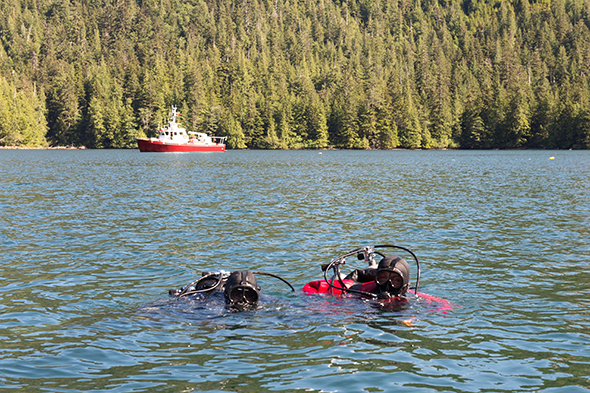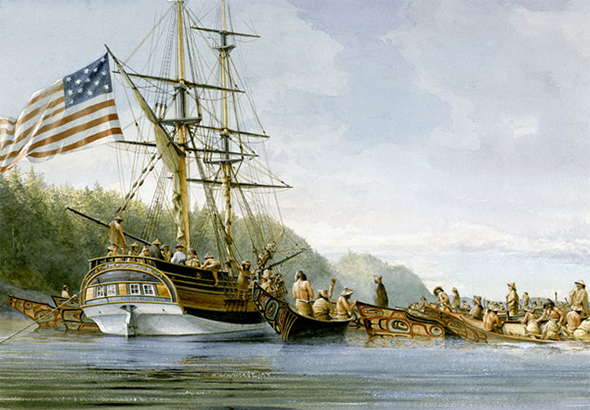Underwater Archaeology
Gwaii Haanas National Park Reserve, National Marine Conservation Area Reserve, and Haida Heritage Site
Searching underwater archaeological sites and shipwrecks in Gwaii Haanas
- Searching for shipwrecks
- Other maritime archaeology in Gwaii Haanas
- Inter-tidal archaeology
- Submerged village sites
For several decades, Parks Canada and its partners have been exploring, studying, protecting and sharing with the public the rich archaeological heritage of Gwaii Haanas National Park Reserve and Haida Heritage Site. Hundreds of sites have been located and documented.
Beginning in the 1990s Parks Canada and its partners began to search in earnest for underwater archaeological sites in what is now the Gwaii Haanas National Marine Conservation Area Reserve. A particular focus of this work was on locating pre-contact sites dating back thousands of years, many of which are presumed to have been submerged by rising sea levels.
In June 2014, Parks Canada’s Underwater Archaeology Service (UAS) conducted a two-week search using targeted diving and remote sensing, including side-scan sonars, magnetometers and an autonomous underwater vehicle. In particular, the UAS searched for historic shipwrecks.

Searching for shipwrecks
In 2013, Parks Canada partnered with the Underwater Archaeological Society of British Columbia (UASBC) to enhance its historic shipwreck database of Gwaii Haanas. Parks Canada now has a better understanding of how many historic shipwrecks might be in Gwaii Haanas National Marine Conservation Area Reserve and in the nearby waters.
While the majority of known shipwrecks in Gwaii Haanas date from the late nineteenth to twentieth centuries, several historic wrecks are notable for their early date. Two of these ships arrived on the coast in the early days of the maritime fur trade in 1794 and the other arrived in 1851 during a search for gold:

Image courtesy of Gordon Miller
Ino (1794)
The brig stopped near Kunghit Island to trade in 1794 and was overtaken by Haida. All aboard were killed except one survivor whose story is unknown.
Resolution (1794)
A 90-ton schooner, the Resolution sailed with a companion ship Jefferson in 1793. In early 1794 the two ships separated and the Resolution was never seen again. It had been captured in Cumshewa Inlet by Haida villagers. One crew member survived and was rescued a year later by another fur trade vessel.
Georgiana (1851)
This 25-ton sloop carrying 27 gold prospectors was wrecked in a storm near the entrance to Cumshewa Inlet in 1851 and the crew taken hostage. The passengers were held for ransom for 54 days until a private American ship (Damaris Cove) came to their rescue.
Results
The conditions for preservation of underwater archaeological sites in Gwaii Haanas are very harsh. There is an exceptional amount of wind, wave and current and the team did not find any signs of these centuries-old ships. As a result of the survey and exploration completed over two weeks, Gwaii Haanas staff have a much better understanding of the shipwreck and underwater site preservation potential in Gwaii Haanas and more insights into the physical setting of some of the shipwreck events.
Other maritime archaeology in Gwaii Haanas
In addition to looking for shipwrecks and continuing the search for the earliest Haida sites, the UAS inspected a range of other site types near the shoreline. These include sites and structures associated with past industry and shipping, such as harbours, mines, wharves, piers and middens.
The early decades of the 20th century brought a lot of activity to southern Haida Gwaii. More than 100 years ago at Ikeda Cove, a substantial wharf, two massive bunkers each capable of holding 1,000 tons of ore, brick as well as wood buildings stood. The team recorded the remains of the G. M. Dawson sternwheeler built in 1898 in Vancouver. It was brought in and beached at Ikeda to be used as a bunkhouse.
In 1907, two wharves, a sawmill, hotel, store and numerous cabin homes appeared in Jedway when the lure of possible wealth from the hills drew men from all parts of the world. The team found remains of the wharf at this ghost town, which was once a bustling steamship stop.
They also found several artefacts underwater at Lockeport. Lockeport was a mining and fish cannery town occupied from 1908 until 1941. Even at these industrial sites from the early 20th century, very little is preserved on the seabed.
These targeted explorations add to the underwater inventory of cultural sites in Gwaii Haanas which in turn help Parks Canada protect and interpret these sites for the benefit of Canadians and visitors to Gwaii Haanas. It is anticipated that the search will resume in 2015.
Inter-tidal archaeology
Features such as ancient habitation sites, fish weirs, intertidal gardens and lithic scatters (evidence of stone tool making) are found in inter-tidal sites. Fish weirs (rows of sharpened stakes pounded into streambeds to pen fish), show that the Haida were intensely harvesting salmon at a very early date.
The Haida may have also used intertidal gardens to cultivate shellfish. Although no archaeological evidence of plant cultivation in estuaries has been found in Haida Gwaii, archaeologists are intrigued by early ethnographic observations made by Charles Newcombe in the late 1800s, who described how the Haida cleared stones off their clover gardens and separated them with fences.
Elsewhere on the coast of British Columbia, intertidal gardens were used to cultivate resources such as clams, springbank clover, and pacific silverweed. This exciting research is rewriting the history of First Nations settlement on the Pacific Coast, as it challenges the idea that early coastal populations were exclusively hunters and gatherers.

Submerged village sites
Much of the early history of Haida Gwaii lies below the waters of Hecate Strait due to rapid sea level change between 15,000 and 11,000 years ago. Parks Canada archaeologists and their collaborators have used sea-level reconstruction techniques to search for archaeological sites ranging from submerged coastal sites to upland caves.
A range of scientific methods have been used to search for artefacts underwater, including diving searches and test excavation, grab sampling, coring, and the use of submersibles and remotely operated vehicles. These methods are used on areas identified as having higher potential for human habitation based on landscape reconstruction evidence. This work will continue in 2014.
- Date modified :